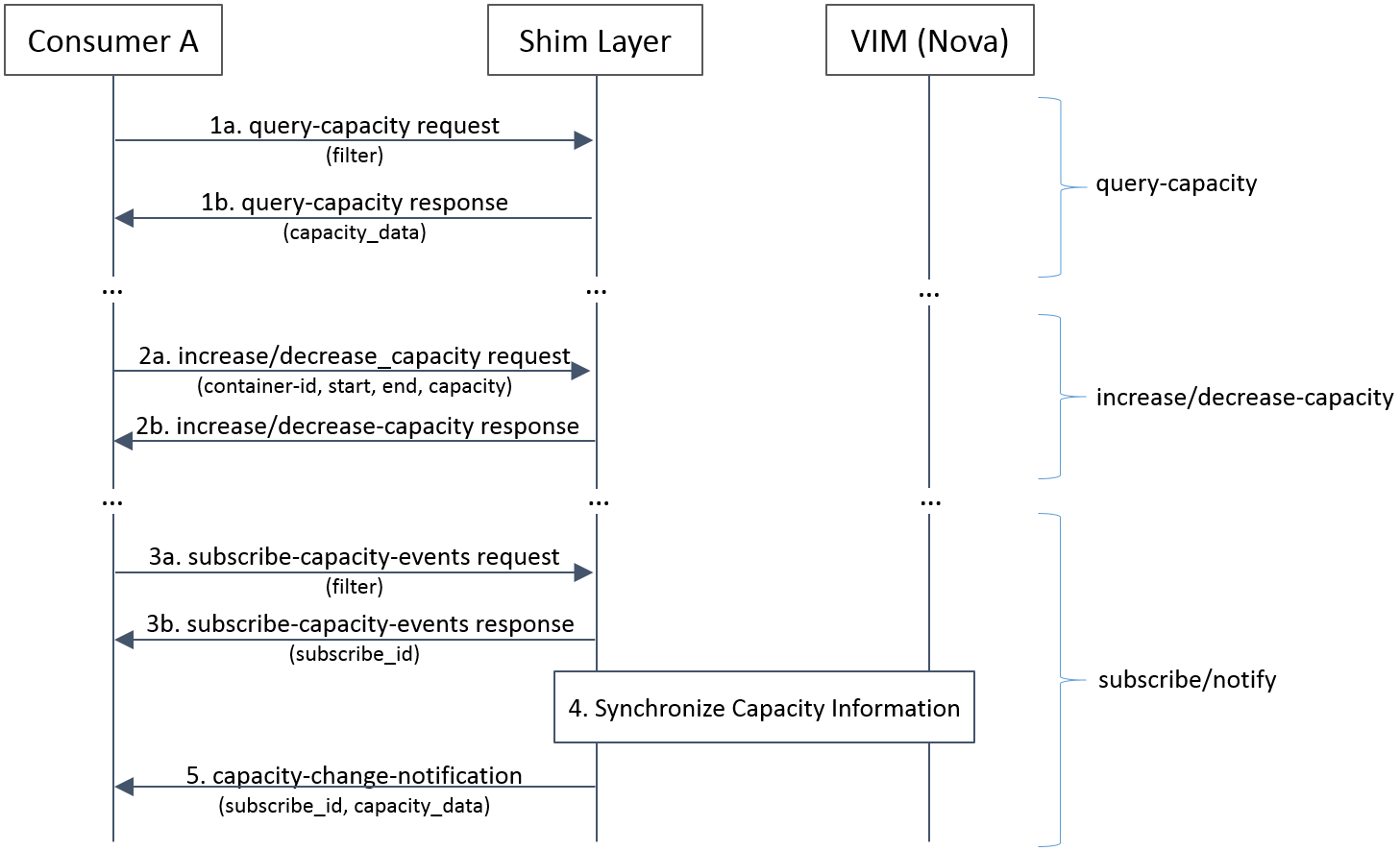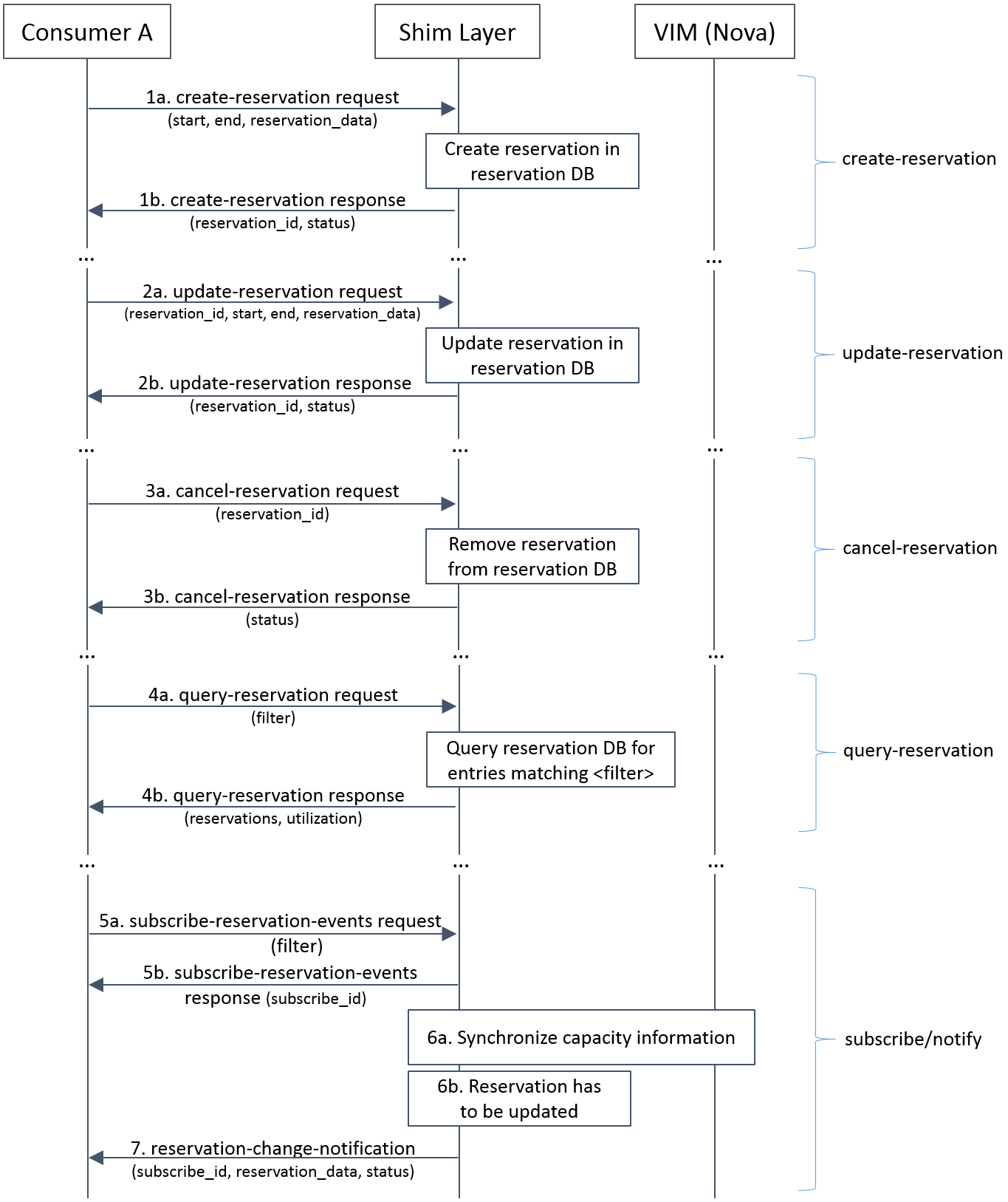6. Detailed architecture and message flows¶
Within the Promise project we consider two different architectural options, i.e. a shim-layer based architecture and an architecture targeting at full OpenStack integration.
6.1. Shim-layer architecture¶
The shim-layer architecture is using a layer on top of OpenStack to provide the capacity management, resource reservation, and resource allocation features.
6.1.1. Detailed Message Flows¶
Note, that only selected parameters for the messages are shown. Refer to Detailed northbound interface specification and Annex ANNEX B: Promise YANG schema based on YangForge for a full set of message parameters.
6.1.1.1. Resource Capacity Management¶

Fig. 6.1 Capacity Management Scenario¶
Fig. 6.1 shows a detailed message flow between the consumers and the capacity management functional blocks inside the shim-layer. It has the following steps:
- Step 1a: The Consumer sends a query-capacity request to Promise using some filter like time-windows or resource type. The capacity is looked up in the shim-layer capacity map.
- Step 1b: The shim-layer will respond with information about the total, available, reserved, and used (allocated) capacities matching the filter.
- Step 2a: The Consumer can send increase/decrease-capacity requests to update the capacity available to the reservation system. It can be 100% of available capacity in the given provider/source or only a subset, i.e., it can allow for leaving some “buffer” in the actual NFVI to be used outside the Promise shim-layer or for a different reservation service instance. It can also be used to inform the reservation system that from a certain time in the future, additional resources can be reserved (e.g. due to a planned upgrade of the capacity), or the available capacity will be reduced (e.g. due to a planned downtime of some of the resources).
- Step 2b: The shim-layer will respond with an ACK/NACK message.
- Step 3a: Consumers can subscribe for capacity-change events using a filter.
- Step 3b: Each successful subscription is responded with a subscription_id.
- Step 4: The shim-layer monitors the capacity information for the various types of resources by periodically querying the various Controllers (e.g. Nova, Neutron, Cinder) or by creating event alarms in the VIM (e.g. with Ceilometer for OpenStack) and updates capacity information in its capacity map.
- Step 5: Capacity changes are notified to the Consumer.
6.1.1.2. Resource Reservation¶

Fig. 6.2 Resource Reservation for Future Use Scenario¶
Fig. 6.2 shows a detailed message flow between the Consumer and the resource reservation functional blocks inside the shim-layer. It has the following steps:
- Step 1a: The Consumer creates a resource reservation request for future use by setting a start and end time for the reservation as well as more detailed information about the resources to be reserved. The Promise shim-layer will check the free capacity in the given time window and in case sufficient capacity exists to meet the reservation request, will mark those resources “reserved” in its reservation map.
- Step 1b: If the reservation was successful, a reservation_id and status of the reservation will be returned to the Consumer. In case the reservation cannot be met, the shim-layer may return information about the maximum capacity that could be reserved during the requested time window and/or a potential time window where the requested (amount of) resources would be available.
- Step 2a: Reservations can be updated using an update-reservation, providing the reservation_id and the new reservation_data. Promise Reservation Manageer will check the feasibility to update the reservation as requested.
- Step 2b: If the reservation was updated successfully, a reservation_id and status of the reservation will be returned to the Consumer. Otherwise, an appropriate error message will be returned.
- Step 3a: A cancel-reservation request can be used to withdraw an existing reservation. Promise will update the reservation map by removing the reservation as well as the capacity map by adding the freed capacity.
- Step 3b: The response message confirms the cancelation.
- Step 4a: Consumers can also issue query-reservation requests to receive a list of reservation. An input filter can be used to narrow down the query, e.g., only provide reservations in a given time window. Promise will query its reservation map to identify reservations matching the input filter.
- Step 4b: The response message contains information about all reservations matching the input filter. It also provides information about the utilization in the requested time window.
- Step 5a: Consumers can subscribe for reservation-change events using a filter.
- Step 5b: Each successful subscription is responded with a subscription_id.
- Step 6a: Promise synchronizes the available and used capacity with the underlying VIM.
- Step 6b: In certain cases, e.g., due a failure in the underlying hardware, some reservations cannot be kept up anymore and have to be updated or canceled. The shim-layer will identify affected reservations among its reservation records.
- Step 7: Subscribed Consumers will be informed about the updated reservations. The notification contains the updated reservation_data and new status of the reservation. It is then up to the Consumer to take appropriate actions in order to ensure high priority reservations are favored over lower priority reservations.
6.1.1.3. Resource Allocation¶

Fig. 6.3 Resource Allocation¶
Fig. 6.3 shows a detailed message flow between the Consumer, the functional blocks inside the shim-layer, and the VIM. It has the following steps:
- Step 1a: The Consumer sends a create-instance request providing information about the resources to be reserved, i.e., provider_id (optional in case of only one provider), name of the instance, the requested flavour and image, etc. If the allocation is against an existing reservation, the reservation_id has to be provided.
- Step 1b: If a reservation_id was provided, Promise checks if a reservation with that ID exists, the reservation start time has arrived (i.e. the reservation is active), and the required capacity for the requested flavor is within the available capacity of the reservation. If those conditions are met, Promise creates a record for the allocation (VMState=”INITIALIZED”) and update its databases. If no reservation_id was provided in the allocation request, Promise checks whether the required capacity to meet the request can be provided from the available, non-reserved capacity. If yes, Promise creates a record for the allocation and update its databases. In any other case, Promise rejects the create-instance request.
- Step 2: In the case the create-instance request was rejected, Promise responds with a “status=rejected” providing the reason of the rejection. This will help the Consumer to take appropriate actions, e.g., send an updated create-instance request. The allocation work flow will terminate at this step and the below steps are not executed.
- Step 3a: If the create-instance request was accepted and a related allocation record has been created, the shim-layer issues a createServer request to the VIM Controller providing all information to create the server instance.
- Step 3b: The VIM Controller sends an immediate reply with an instance_id and starts the VIM-internal allocation process.
- Step 4: The Consumer gets an immediate response message with allocation status “in progress” and the assigned instance_id.
- Step 5a+b: The consumer subscribes to receive notifications about allocation events related to the requested instance. Promise responds with an acknowledgment including a subscribe_id.
- Step 6: In parallel to the previous step, Promise shim-layer creates an alarm in Aodh to receive notifications about all changes to the VMState for instance_id.
- Step 7a: The VIM Controller notifies all instance related events to Ceilometer. After the allocation has been completed or failed, it sends an event to Ceilometer. This triggers the OpenStack alarming service Aodh to notify the new VMState (e.g. ACTIVE and ERROR) to the shim-layer that updates its internal allocation records.
- Step 7b: Promise sends a notification message to the subscribed Consumer with information on the allocated resources including their new VMState.
- Step 8a+b: Allocated instances can be terminated by the Consumer by sending a destroy-instance request to the shim-layer. Promise responds with an acknowledgment and the new status “DELETING” for the instance.
- Step 9a: Promise sends a deleteServer request for the instance_id to the VIM Controller.
- Step 10a: After the instance has been deleted, an event alarm is sent to the shim-layer that updates its internal allocation records and capacity utilization.
- Step 10b: The shim-layer also notifies the subscribed Consumer about the successfully destroyed instance.
6.2. Integrated architecture¶
The integrated architecture aims at full integration with OpenStack. This means that it is planned to use the already existing OpenStack APIs extended with the reservation capabilities.
The advantage of this approach is that we don’t need to re-model the complex resource structure we have for the virtual machines and the corresponding infrastructure.
The atomic item is the virtual machine with the minimum set of resources it requires to be able to start it up. It is important to state that resource reservation is handled on VM instance level as opposed to standalone resources like CPU, memory and so forth. As the placement is an important aspect in order to be able to use the reserved resources it provides the constraint to handle resources in groups.
The placement constraint also makes it impossible to use a quota management system to solve the base use case described earlier in this document.
OpenStack had a project called Blazar, which was created in order to provide resource reservation functionality in cloud environments. It uses the Shelve API of Nova, which provides a sub-optimal solution. Due to the fact that this feature blocks the reserved resources this solution cannot be considered to be final. Further work is needed to reach a more optimal stage, where the Nova scheduler is intended to be used to schedule the resources for future use to make the reservations.
6.2.1. Phases of the work¶
The work has two main stages to reach the final solution. The following main work items are on the roadmap for this approach:
Sub-optimal solution by using the shelve API of Nova through the Blazar project:
Fix the code base of the Blazar project:
Due to integration difficulties the Blazar project got suspended. Since the last activities in that repository the OpenStack code base and environment changed significantly, which means that the project’s code base needs to be updated to the latest standards and has to be able to interact with the latest version of the other OpenStack services.
Update the Blazar API:
The REST API needs to be extended to contain the attributes for the reservation defined in this document. This activity shall include testing towards the new API.
Use Nova scheduler to avoid blocking the reserved resources:
Analyze the Nova scheduler:
The status and the possible interface between the resource reservation system and the Nova scheduler needs to be identified. It is crucial to achieve a much more optimal solution than what the current version of Blazar can provide. The goal is to be able to use the reserved resources before the reservation starts. In order to be able to achieve this we need the scheduler to do scheduling for the future considering the reservation intervals that are specified in the request.
Define a new design based on the analysis and start the work on it:
The design for the more optimal solution can be defined only after analyzing the structure and capabilities of the Nova scheduler.
This phase can be started in parallel with the previous one.
